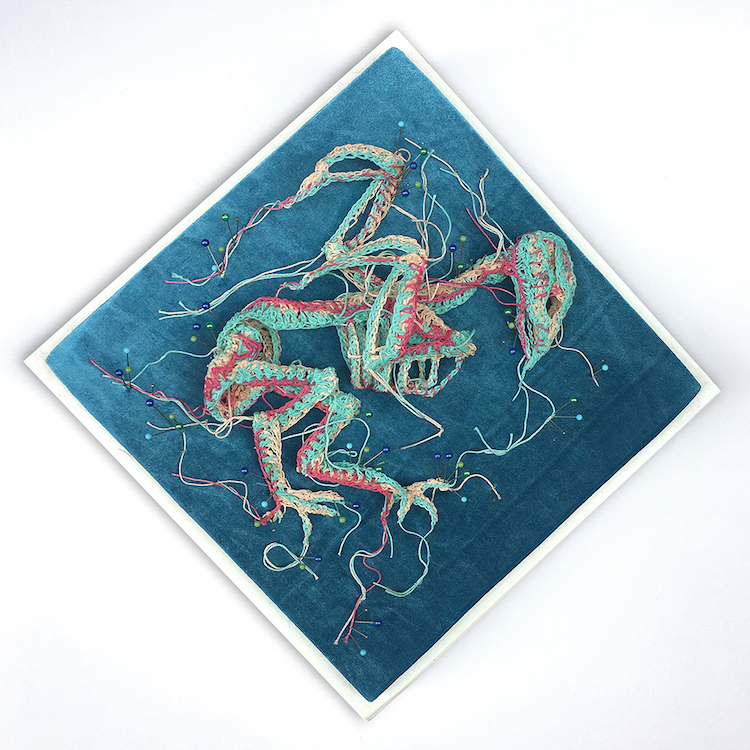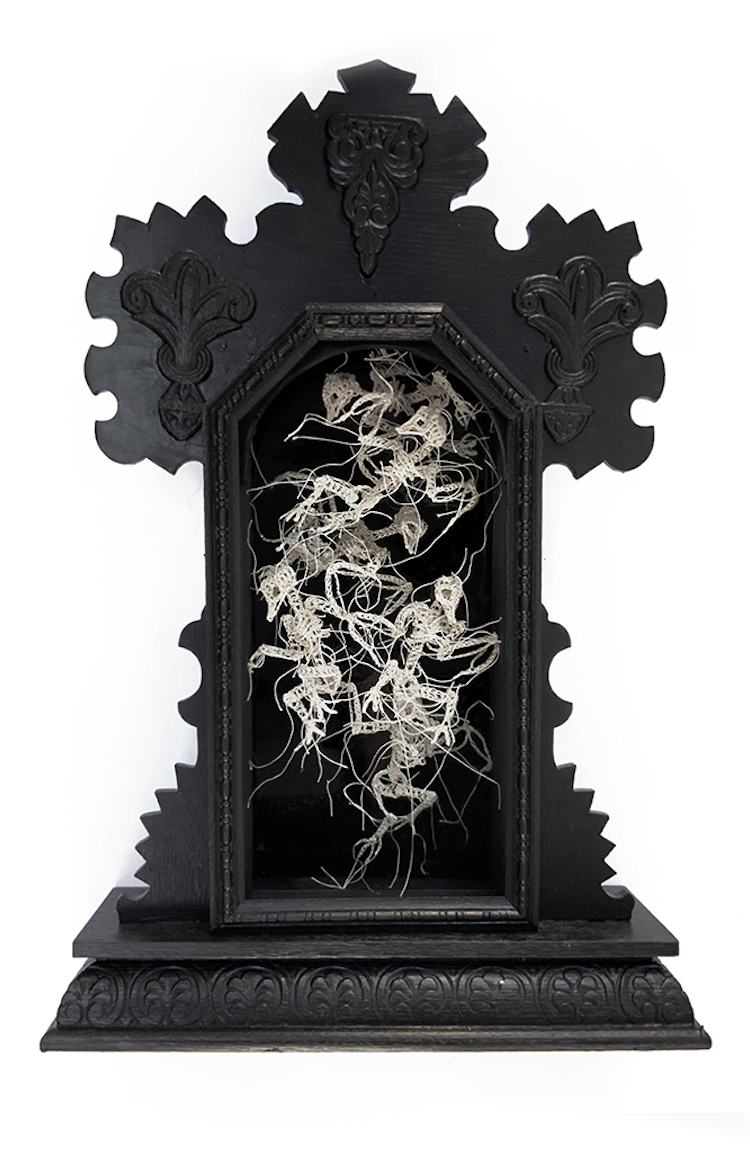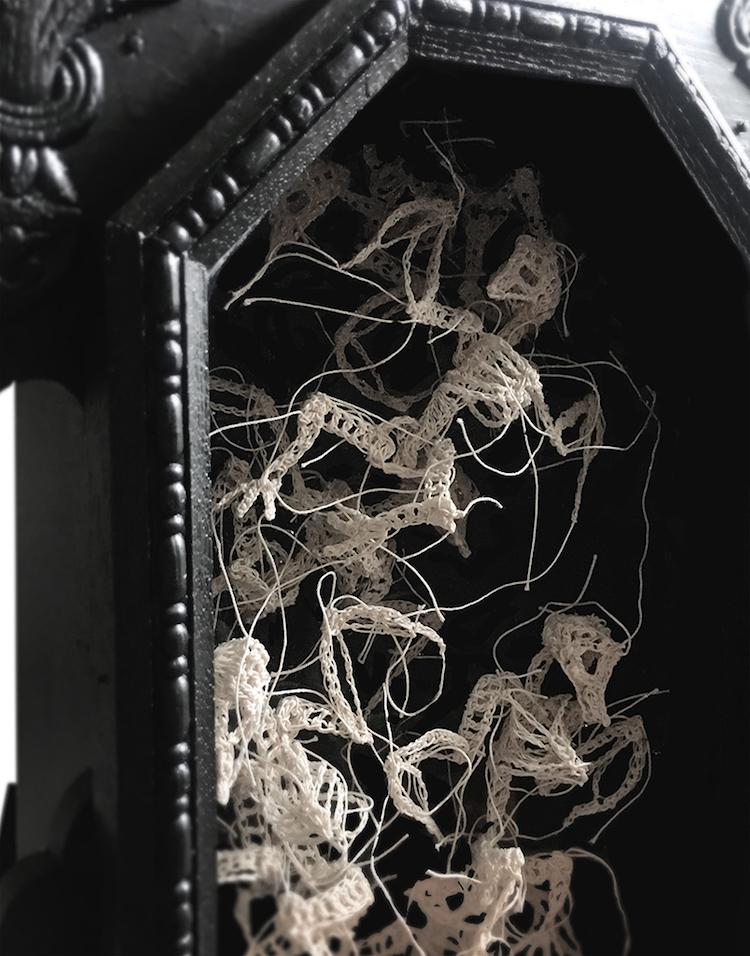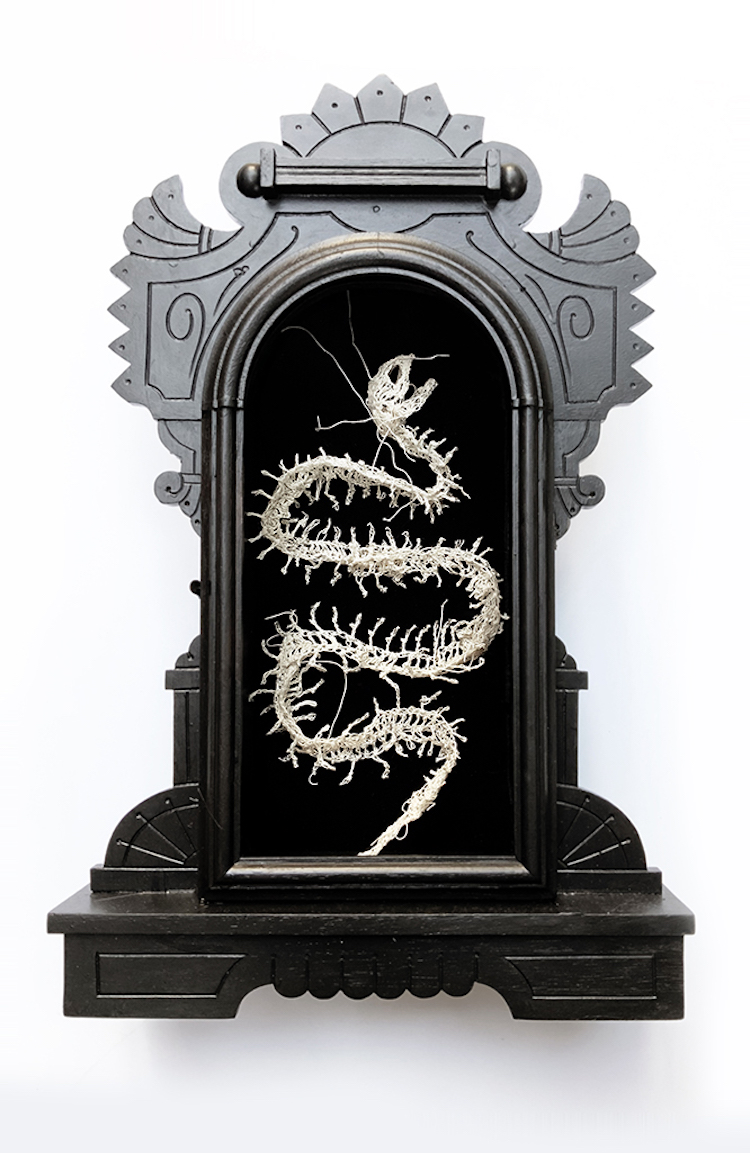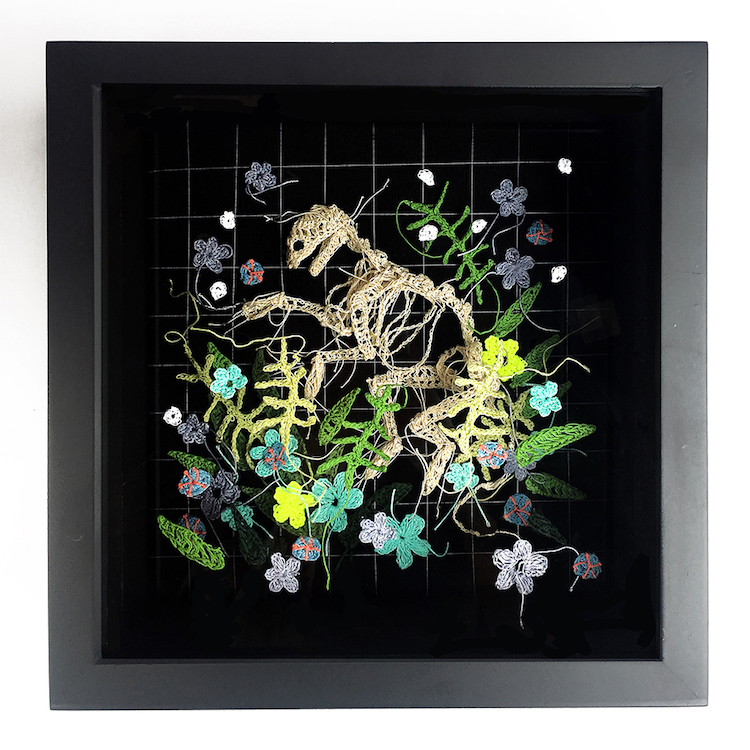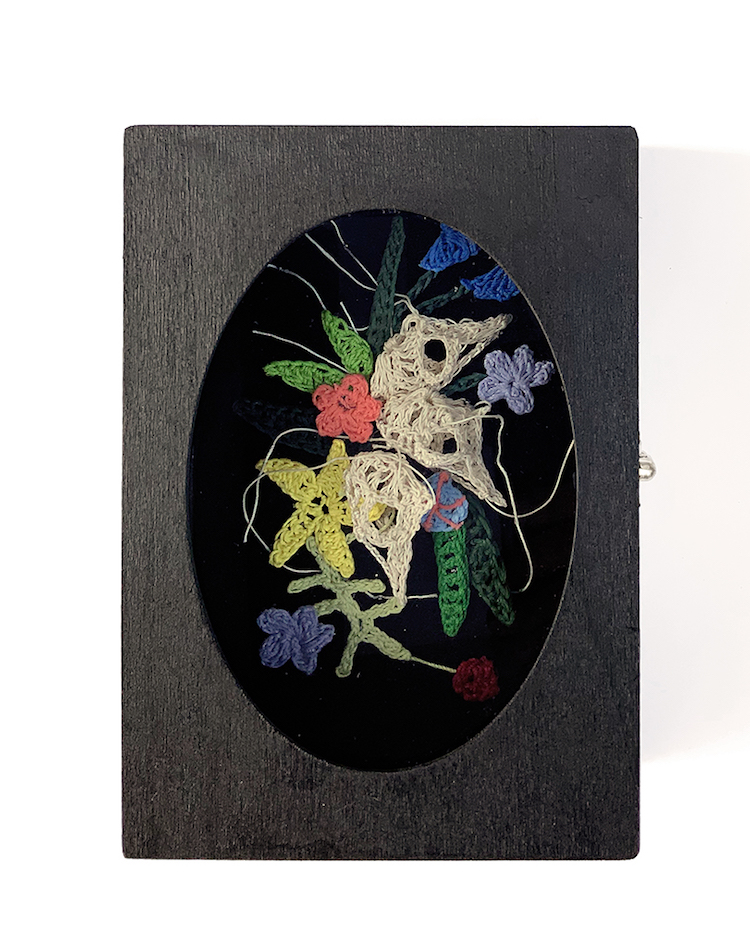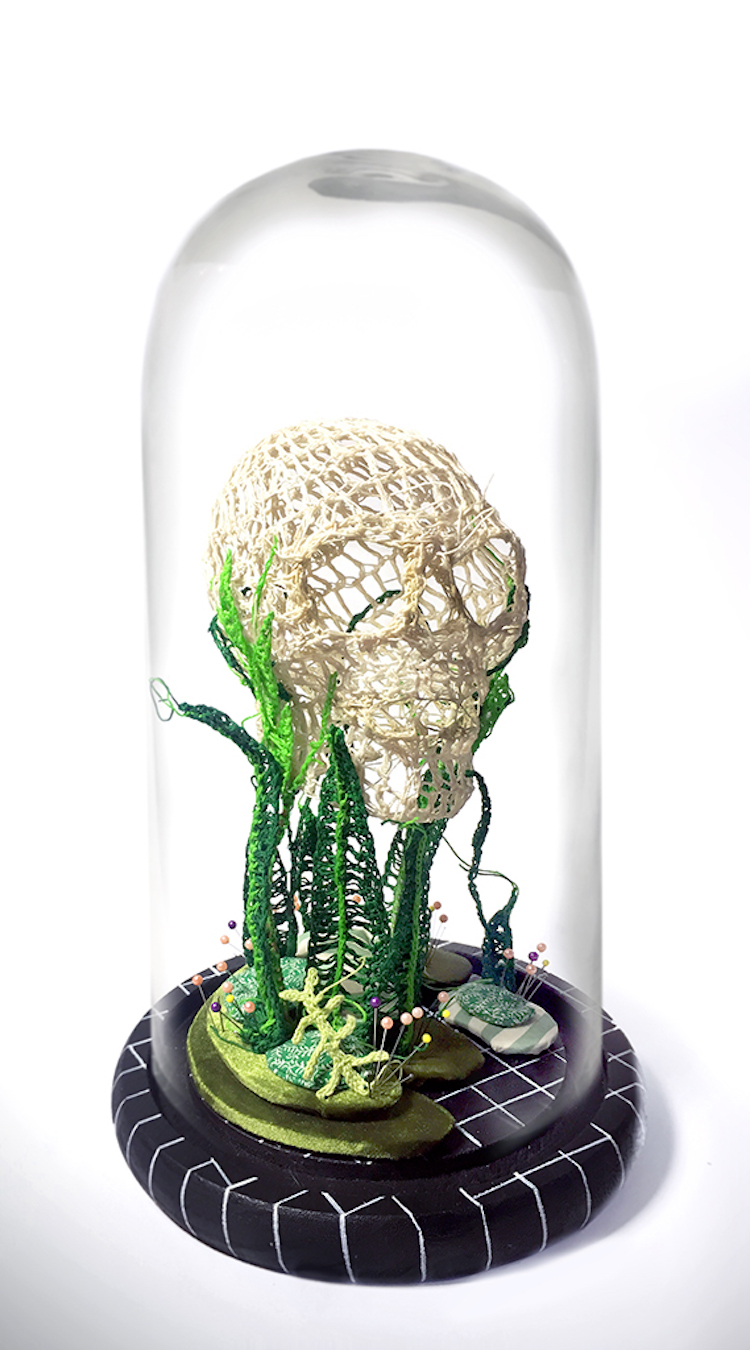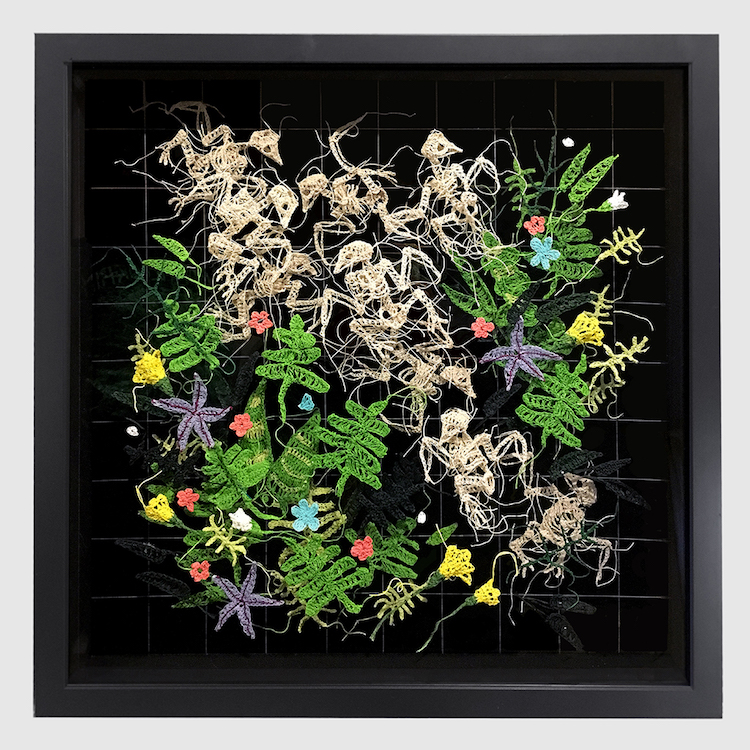Crochet art has always had a folklorish narrative to it. Caitlin McCormack takes that history and flips the idea on its head. Not that textile art or crochet can't have a little bit of macabre to it; history and the things we pass down to each other can always have a little darkness and mystery. But the Philadelphia-based artist, who opens her new solo show, Granny, at Hashimoto Contemporary in San Francisco on October 5th, balances our collective idea of what handmade crochet work means in history and what boundaries she can push into creating work that is "eerily morbid and whimsically beautiful." Lyndsie Fox recently sat down with McCormack to learn more about her process, the upcoming exhibition and the meaning of Granny.

Lyndsie Fox: Hi, Caitlin! Thank you so much for taking the time to talk to me! I’m a huge fan of your work and, as a fiber artist myself, I have so much appreciation for the time and energy you put into your craft. Every stitch, every knot, every string–it’s truly a labor of love (and I’m sure you, too, have the carpal tunnel to prove it.)
Caitlin McCormack: That's really kind of you. And yes, definitely, the carpal tunnel is very present. My wrist also sounds like a mouthful of granola being crunched when I rotate it. I don't know what that means, but it can't be good.
Beyond your processes and inspiration, I’d love to delve into the psychology of your work and your experience as an artist. But, for those who are unfamiliar with your work, can you give a quick overview of your process and why you started crocheting this series?
I began working in this medium right after I got my Illustration BFA. My grandparents passed away shortly after that, and my family was all out of sorts. I started crocheting mindlessly, using my grandmother's age-stained cotton doily thread, in an attempt to steer myself into a meditative, serene state. On a whim, I applied some glue to it and noticed that the results of that experiment were reminiscent of microscopic images of bone tissue. That realization, in light of events at the time, seemed to make sense. What started as a coping mechanism transformed into an homage to my grandparents. The skeletal forms were a hybrid of my grandmother's delicate crocheted pieces and my grandfather's beautifully carved wooden birds.
I'll try to keep this short, but my process entails observing an osteological specimen, either in person or via a photo from a book, drawing sketches from memory to ensure that it isn't too accurate and that my visual biases are warping my recollection of the form, and then crocheting the bones piece by piece out of string, with a tiiiiny hook. The individual pieces are dredged in a mixture of glues, over and over and over again, until they have a level of rigidity similar to a fishbone. I sew them together and suddenly there's a skeleton in my hands.

Contrary to your trademark black and white motif, you include much more color in this new body of work for GRANNY. These bright colors and florals lend themselves more light-hearted, almost cartoonish, whimsical work, even when paired with the more macabre, skeletal forms. Were the vivid colors and floral elements a purely aesthetic choice or were they, like much of your subject matter and practice, influenced by recent moods and life events?
For a long time, so much of my work was about using the form of an animal, emblematic of a life event, to sort of trap a memory in the knots. I realized that I was repeatedly working with a limited set of creatures, which have transformed into a cast of characters symbolizing a more streamlined set of emotions. I've moved on, striving to situate them in more elaborate environments, and color is so integral to that. I was limiting myself for so long! Humor is also extremely important to me, and I have desperately been wanting to incorporate it into my work – I'm currently trying to move towards a brighter, more abstract way of conceptualizing what I do, but it's very hard to do that gracefully. I don't know why I'm placing so much emphasis on grace, haha.

I noticed some technical contrast in your new works. Your trademark skeletal forms are very detailed and tightly rendered but your florals seem a bit looser. Was this a conscious choice–part of the whimsy and charm inherent to bright florals–or was it a restriction of depicting a new subject matter?
The looseness of the colorful components is definitely intentional. It's cool that you noticed that because, as an insecure person, I'm always afraid that someone will think, “Oh god, she sucks, what even is this? Take it down, throw it in the trash.” I kind of think it's funny. Placing these super serious, very delicate, lace avian skeletons in like a bizarro world of naïve floral forms is very hilarious to me. Like a Victorian mourner has wandered into the kitchen section at IKEA and has absolutely no idea what to make of it all.
Because your work takes so long to manipulate and dry (you once said the process could take anywhere from two weeks to eight months), do you ever find that the vision you set out to create morphs into something completely different throughout the process? Can you speak more to the limitations of this process of hand-crocheted sculpture versus your previous explorations in painting and drawing?
Definitely, this happens all the time. At this point, I'm pretty adept at maintaining accuracy where the crochet aspect of the process is concerned, but when the pieces are glued up and are laying out to dry, they respond to the ambient qualities of my studio. If it's super humid, they wind up looking extra flat. If I have a visitor, the pieces might warp slightly to one side because of the wind generated by a person walking across the room. I'm very fascinated by how these nuances can be programmed into the outcome of a project and always welcome the variants, when they manifest. I prefer it to the more controlled way I draw.
Does the length of your process ever frustrate you?
Oh yeah, for sure. But it also gives endless excuses for me to break plans with people, which is just fantastic. It all works out.

Fiber arts have long been deemed a hyper-feminine realm, relegated to female domestic homemakers and juvenile craft-women, a mentality perpetuated by social stereotypes of gender roles, domestic life, and gender binary systems. It’s a tired question every contemporary female fiber artist has been asked a million times before, and the question itself, while valid, is problematic. A female painter would never be asked why she paints. But I have to ask, what has been your experience navigating the art world as a young female contemporary artist practicing a traditionally domestic craft? Do you even consider these stereotypes and historical projections, or do you feel untouched by it all?
Whenever I'm talking about my work with someone at an exhibit or an art fair, and the word “crochet” is introduced, it's almost a guarantee that the person's eyes will just drop to the floor. I'm usually speaking with a man in this situation, but not always. The fact that my medium might place limitations on how far my career can extend itself, and how seriously my work is taken is one of my most overwhelming and loathsome insecurities. It obviously arouses fear but also makes me so angry at myself for second-guessing my medium for reasons that are skewed by a sexist, ageist, and probably classist lens. An artist should constantly scrutinize their medium, but for their own reasons, not because their technique is, say, commonly associated with old women, which, for some reason, places it in an inescapable “cute” box (at best). Half of the reason my show is called Granny pertains to this crap. I'm Granny.
You’ve talked about mental health and your experiences with issues like anxiety. Newer generations and younger artists are generally more open about the status of their mental health and the way it affects their craft and success. Do you feel like the inherently judgmental and rejective nature of the art world has impacted your mental health? How do you navigate the conflict of being driven to create in the face of art world criticism?
Attempting to exist as an artist, especially on social media, has completely restructured the way I navigate depressive and anxious thoughts, in a negative sense. It's definitely important to be transparent about that, and I'm glad that there's currently a widespread conversation being had. I think I'm able to continue going to my studio, in spite of being crushed by self-doubt and never-ending distress, because making art has consistently been one of my most effective coping mechanisms. My mental health has always been a giant blazing dumpster, but I can't think of a single crisis during my lifetime that wasn't ameliorated even slightly by using my hands to make something.

You have been exploring other mediums lately in an effort to detach from your cultivated persona of “crochet artist.” When did you start moving away from crochet works? The recent experiments with ceramics have an affinity with your crocheted works; delicate, spindly, intricate skeleton forms. Will you continue your series of skeletal figures with clay, or are you interested in new subject matter?
I'm just a delicate, spindly kinda guy, you know? I think I'm always going to gravitate towards those forms. Even though pursuing ceramics was initially an attempt to plunge myself into scary and unfamiliar territory, I was ecstatic to find that the experience of working with clay has a lot in common with fibers, especially where my process is concerned, with all the dipping and drying and waiting. I definitely want to continue exploring ceramics but also want to mess around with some other stuff. The past few years have required constant dedication to this one medium and I'm pretty desperate to extend myself, at least a little bit.
Your inspiration and process stems from your grandparents’ legacies, including your grandma’s work with doilies and textiles. You even started out your crochet practices years ago with the same cotton strings your grandma had once used. After all these years, is the sentiment still tied up (no pun intended) in the materials or in the actual ritual of creating the work?
The seed is definitely still there. I think of thread as the basic cellular unit of my work, like, if you were to examine the creatures I make through a scientific lens (as if I am in any way competent enough to speak about that), their biology would all stem from that one old ball of my grandmother's string. The associations that I have with thread will always be programmed into the work, but that doesn't necessarily have to be an element that is communicated. It's just for me, maybe.

Knowing your history as an artist who creates from a strongly emotional, nostalgic and psychological space, do your ceramic (or other media) works hold the same weight for you personally? Can you speak to these new explorations as they relate to your psychological, sentimental, and memorial inspirations?
This might be hinged on the fact that basically all I do is crochet, which is so entwined with my identity, but when I work with another medium, I feel as though I'm in a costume, and the experience is extremely liberating. You know how sometimes it feels as though you can sing better if you do it in a silly voice, as opposed to your normal voice? I don't know if that's a relatable comparison, but I guess what I'm saying is that, occasionally, using media that is alien to me allows a different persona. I get to take a break from being me, and I can use these foreign materials to pillage fictional narratives and explore concepts that I typically wouldn't touch, without the presence of all my usual emotional baggage and default conceptual resources. Sometimes it feels like a performance and I like it.
I’m so excited to see how your work progresses as you move away from crochet! With that in mind, is there anything you’d like to share about recent projects or any upcoming shows?
Thanks, Lyndsie, that really means a lot. I made a feeble attempt to clear my schedule in 2020 for this project I've been working on, called Sleeping In A Bed, where I sleep in my bed for more than three hours and somehow get my body to function somewhat normally. It's going to be a challenge, but we'll see how it goes. It may be preceded by a performance called Taking A Shower but that might fall through. I also have a mural project coming up in Philadelphia, which I'm very excited about. My main goal for the future is to create things that make me laugh. That's important.
Granny is a solo exhibition by Caitlin McCormack opening Saturday, October 5th at Hashimoto Contemporary San Francisco.



